Stakeholder Analysis: Internal and External of Qantas Airways
VerifiedAdded on 2022/09/22
|16
|3852
|53
Report
AI Summary
This report provides a comprehensive analysis of Qantas Airways, focusing on its internal and external stakeholders. It begins with an executive summary and background information on Qantas, including its functional areas such as HR, finance, marketing, and operations. The report identifies and describes the roles of key stakeholders like employees, board of directors, customers, suppliers, government, and competitors. It delves into the nature and degree of stakeholder interest, potential conflicts, and the level of influence each stakeholder holds. A stakeholder matrix is constructed to visualize these relationships. The report also includes a comparison between Qantas Airways and Vodafone India, offering a broader perspective on stakeholder dynamics. Finally, the report concludes with key findings and insights into the Qantas Airways business environment.

1
BUSINESS ENVIRONEMENT
Internal and External stakeholders’ analysis of Qantas Airways
Name
Institution
BUSINESS ENVIRONEMENT
Internal and External stakeholders’ analysis of Qantas Airways
Name
Institution
Paraphrase This Document
Need a fresh take? Get an instant paraphrase of this document with our AI Paraphraser

2
BUSINESS ENVIRONEMENT
Executive summary
Qantas Airways is flag carrier airlines organizations operating in Australia. The Airways was
founded in 1920
Qantas Airways has various functional areas including human resource (HR), accounting and
finance, marketing and advertisement, Research and Development (R&D), Information
Technology (IT), customer service, purchasing, legal department and legal department. The
functional areas that have been prioritized over the last decades include operational department,
marketing, finance and research and development (R&D) department as the company have
significantly differentiated its product as compared to competitors.
The internal stakeholders of Qantas Airways include employees, the board of directors,
supervisors and managers.
The external stakeholders of Qantas Airways include customers, suppliers, society, government,
investors, regulators, creditors and media
The suppliers, competitors, customers, employees and board of directors have a high degree and
nature of interest. However, competitors, investors and media have a low degree and nature of
interest in relation to the Qantas operations.
Investors and suppliers have a low influence on Qantas Airways. Board of directors, managers,
employees, customers and media have a high influence.
In comparison, customers of Qantas have low interest in business whereas those of Vodafone
Company have a high interest. Media have high interest and influence in Vodafone whereas in
Qantas media have low interest but high influence. Competitors of Qantas have a high interest
and influence of business whereas, in Vodafone India, investors and competitors have low
interest and influence of the business.
BUSINESS ENVIRONEMENT
Executive summary
Qantas Airways is flag carrier airlines organizations operating in Australia. The Airways was
founded in 1920
Qantas Airways has various functional areas including human resource (HR), accounting and
finance, marketing and advertisement, Research and Development (R&D), Information
Technology (IT), customer service, purchasing, legal department and legal department. The
functional areas that have been prioritized over the last decades include operational department,
marketing, finance and research and development (R&D) department as the company have
significantly differentiated its product as compared to competitors.
The internal stakeholders of Qantas Airways include employees, the board of directors,
supervisors and managers.
The external stakeholders of Qantas Airways include customers, suppliers, society, government,
investors, regulators, creditors and media
The suppliers, competitors, customers, employees and board of directors have a high degree and
nature of interest. However, competitors, investors and media have a low degree and nature of
interest in relation to the Qantas operations.
Investors and suppliers have a low influence on Qantas Airways. Board of directors, managers,
employees, customers and media have a high influence.
In comparison, customers of Qantas have low interest in business whereas those of Vodafone
Company have a high interest. Media have high interest and influence in Vodafone whereas in
Qantas media have low interest but high influence. Competitors of Qantas have a high interest
and influence of business whereas, in Vodafone India, investors and competitors have low
interest and influence of the business.
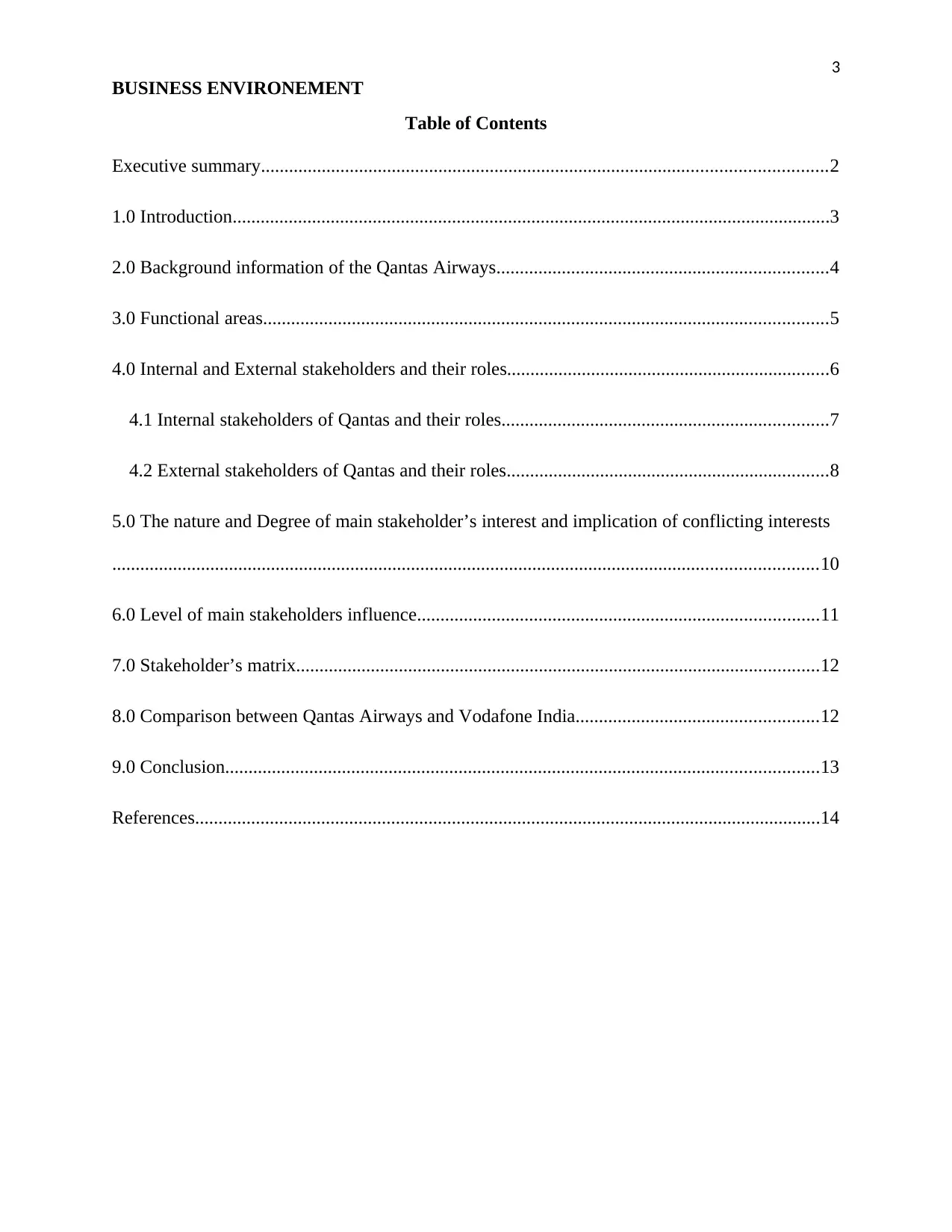
3
BUSINESS ENVIRONEMENT
Table of Contents
Executive summary.........................................................................................................................2
1.0 Introduction................................................................................................................................3
2.0 Background information of the Qantas Airways.......................................................................4
3.0 Functional areas.........................................................................................................................5
4.0 Internal and External stakeholders and their roles.....................................................................6
4.1 Internal stakeholders of Qantas and their roles......................................................................7
4.2 External stakeholders of Qantas and their roles.....................................................................8
5.0 The nature and Degree of main stakeholder’s interest and implication of conflicting interests
.......................................................................................................................................................10
6.0 Level of main stakeholders influence......................................................................................11
7.0 Stakeholder’s matrix................................................................................................................12
8.0 Comparison between Qantas Airways and Vodafone India....................................................12
9.0 Conclusion...............................................................................................................................13
References......................................................................................................................................14
BUSINESS ENVIRONEMENT
Table of Contents
Executive summary.........................................................................................................................2
1.0 Introduction................................................................................................................................3
2.0 Background information of the Qantas Airways.......................................................................4
3.0 Functional areas.........................................................................................................................5
4.0 Internal and External stakeholders and their roles.....................................................................6
4.1 Internal stakeholders of Qantas and their roles......................................................................7
4.2 External stakeholders of Qantas and their roles.....................................................................8
5.0 The nature and Degree of main stakeholder’s interest and implication of conflicting interests
.......................................................................................................................................................10
6.0 Level of main stakeholders influence......................................................................................11
7.0 Stakeholder’s matrix................................................................................................................12
8.0 Comparison between Qantas Airways and Vodafone India....................................................12
9.0 Conclusion...............................................................................................................................13
References......................................................................................................................................14
⊘ This is a preview!⊘
Do you want full access?
Subscribe today to unlock all pages.

Trusted by 1+ million students worldwide

4
BUSINESS ENVIRONEMENT
1.0 Introduction
Conducting a thorough analysis of a business environment is essential for the
identification of diverse types of stakeholders that impacts the operation of an organization.
Stakeholders differ on age, size, business environment and type of industry an organization
operates. Stakeholders are grouped into two categories of internal and external stakeholders.
Some organizations have a higher number of internal and external stakeholders than others
depending on the business functional areas, product cycle, processes and business macro and
microenvironment it operates. Therefore, the report tends to examine the functional areas of
Qantas Airways, identify internal and external stakeholders of the company together with their
roles, identify the nature and degree of main stakeholder’s interest and implication on conflict of
interest, determine the level of Quant’s main stakeholders influence, create stakeholders matrix
of the company upon analyzing the interest and influence of stakeholders and provide
comparison between Qantas Airways of Australia and Vodafone India.
2.0 Background information of the Qantas Airways
Qantas Airways is flag carrier airlines organizations operating in Australia that has
gained the largest fleet size based on international destinations and international flights. Qantas is
considered to be the oldest airlines in the entire world after KLM and Avianca and was
established in the year 1920. The organization started its international flights in the year 1935
and is based in Sydney (Qantas.com. 2019). The share that has been currently developed by
Qantas within the year 2014 is 65% of the domestic market of Australia and the organization
carried 14.9% of the total passengers who travel in and out of the country. The subsidiary airlines
of Qantas Airways operate in different parts of the country in order to serve the domestic
customers (Qantas.com. 2019). Qantas also owns the low-cost based airlines' organization Jetstar
BUSINESS ENVIRONEMENT
1.0 Introduction
Conducting a thorough analysis of a business environment is essential for the
identification of diverse types of stakeholders that impacts the operation of an organization.
Stakeholders differ on age, size, business environment and type of industry an organization
operates. Stakeholders are grouped into two categories of internal and external stakeholders.
Some organizations have a higher number of internal and external stakeholders than others
depending on the business functional areas, product cycle, processes and business macro and
microenvironment it operates. Therefore, the report tends to examine the functional areas of
Qantas Airways, identify internal and external stakeholders of the company together with their
roles, identify the nature and degree of main stakeholder’s interest and implication on conflict of
interest, determine the level of Quant’s main stakeholders influence, create stakeholders matrix
of the company upon analyzing the interest and influence of stakeholders and provide
comparison between Qantas Airways of Australia and Vodafone India.
2.0 Background information of the Qantas Airways
Qantas Airways is flag carrier airlines organizations operating in Australia that has
gained the largest fleet size based on international destinations and international flights. Qantas is
considered to be the oldest airlines in the entire world after KLM and Avianca and was
established in the year 1920. The organization started its international flights in the year 1935
and is based in Sydney (Qantas.com. 2019). The share that has been currently developed by
Qantas within the year 2014 is 65% of the domestic market of Australia and the organization
carried 14.9% of the total passengers who travel in and out of the country. The subsidiary airlines
of Qantas Airways operate in different parts of the country in order to serve the domestic
customers (Qantas.com. 2019). Qantas also owns the low-cost based airlines' organization Jetstar
Paraphrase This Document
Need a fresh take? Get an instant paraphrase of this document with our AI Paraphraser
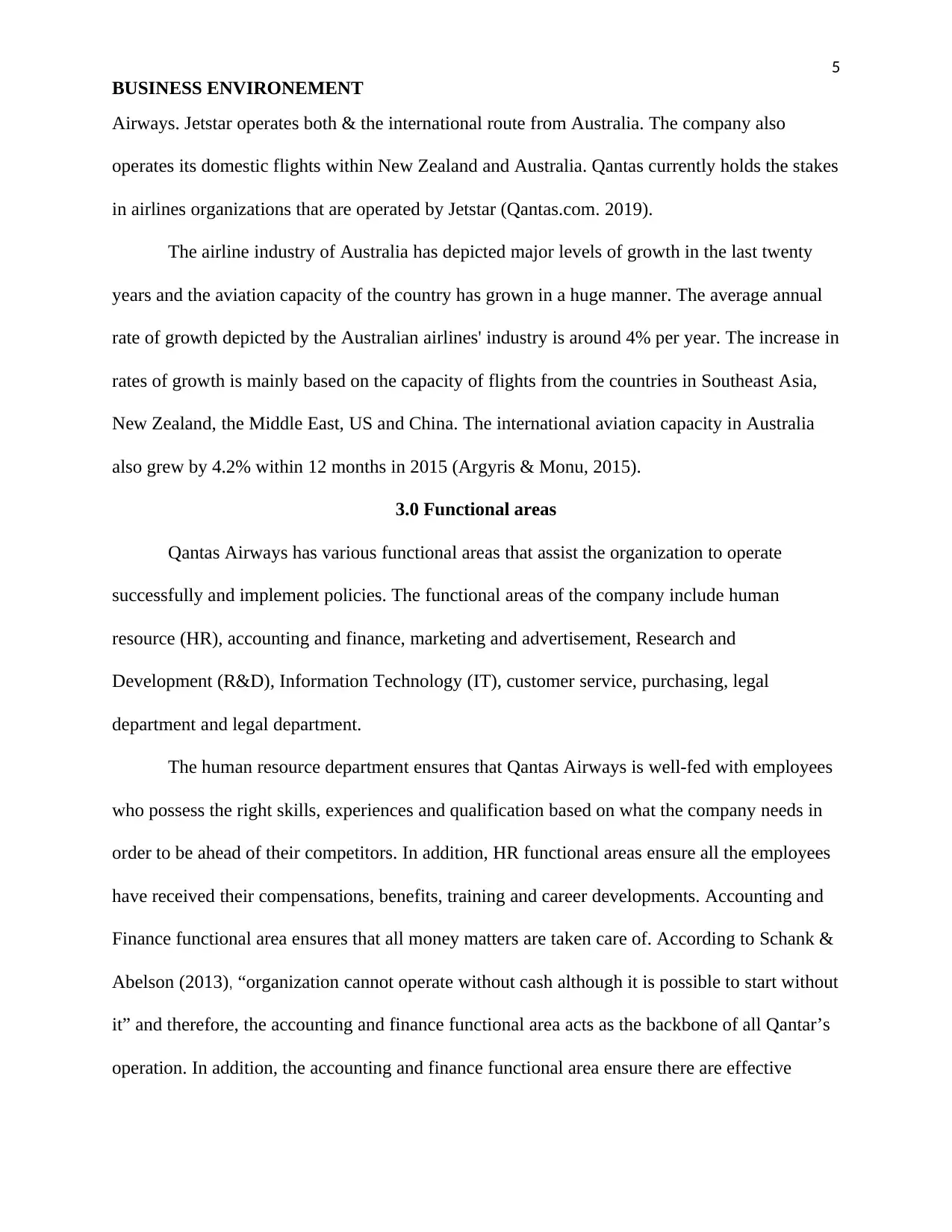
5
BUSINESS ENVIRONEMENT
Airways. Jetstar operates both & the international route from Australia. The company also
operates its domestic flights within New Zealand and Australia. Qantas currently holds the stakes
in airlines organizations that are operated by Jetstar (Qantas.com. 2019).
The airline industry of Australia has depicted major levels of growth in the last twenty
years and the aviation capacity of the country has grown in a huge manner. The average annual
rate of growth depicted by the Australian airlines' industry is around 4% per year. The increase in
rates of growth is mainly based on the capacity of flights from the countries in Southeast Asia,
New Zealand, the Middle East, US and China. The international aviation capacity in Australia
also grew by 4.2% within 12 months in 2015 (Argyris & Monu, 2015).
3.0 Functional areas
Qantas Airways has various functional areas that assist the organization to operate
successfully and implement policies. The functional areas of the company include human
resource (HR), accounting and finance, marketing and advertisement, Research and
Development (R&D), Information Technology (IT), customer service, purchasing, legal
department and legal department.
The human resource department ensures that Qantas Airways is well-fed with employees
who possess the right skills, experiences and qualification based on what the company needs in
order to be ahead of their competitors. In addition, HR functional areas ensure all the employees
have received their compensations, benefits, training and career developments. Accounting and
Finance functional area ensures that all money matters are taken care of. According to Schank &
Abelson (2013), “organization cannot operate without cash although it is possible to start without
it” and therefore, the accounting and finance functional area acts as the backbone of all Qantar’s
operation. In addition, the accounting and finance functional area ensure there are effective
BUSINESS ENVIRONEMENT
Airways. Jetstar operates both & the international route from Australia. The company also
operates its domestic flights within New Zealand and Australia. Qantas currently holds the stakes
in airlines organizations that are operated by Jetstar (Qantas.com. 2019).
The airline industry of Australia has depicted major levels of growth in the last twenty
years and the aviation capacity of the country has grown in a huge manner. The average annual
rate of growth depicted by the Australian airlines' industry is around 4% per year. The increase in
rates of growth is mainly based on the capacity of flights from the countries in Southeast Asia,
New Zealand, the Middle East, US and China. The international aviation capacity in Australia
also grew by 4.2% within 12 months in 2015 (Argyris & Monu, 2015).
3.0 Functional areas
Qantas Airways has various functional areas that assist the organization to operate
successfully and implement policies. The functional areas of the company include human
resource (HR), accounting and finance, marketing and advertisement, Research and
Development (R&D), Information Technology (IT), customer service, purchasing, legal
department and legal department.
The human resource department ensures that Qantas Airways is well-fed with employees
who possess the right skills, experiences and qualification based on what the company needs in
order to be ahead of their competitors. In addition, HR functional areas ensure all the employees
have received their compensations, benefits, training and career developments. Accounting and
Finance functional area ensures that all money matters are taken care of. According to Schank &
Abelson (2013), “organization cannot operate without cash although it is possible to start without
it” and therefore, the accounting and finance functional area acts as the backbone of all Qantar’s
operation. In addition, the accounting and finance functional area ensure there are effective

6
BUSINESS ENVIRONEMENT
reporting and financial statements which helps in forecasting, budgeting and decision-making
processes of the company.
Marketing and advertising functional area of Qantas promotes the business to the outside
world. The functional area develops the products, packaging, pricing and design creative
materials that attract the interest of targeted customers. The functional area also carries annual
surveys to understand needs and wants of customers, manages the brand, creates content for
websites, manages and monitors social media and produces internal marketing communication
for the Qantas’s employees. ICT functional area of Qantas is responsible for architecture,
software, hardware and networking of computers in the company. Operation functional area of
the company redesigns and controls the operation of the company. Customer service functional
area is responsible for interacting with customers, addressing customers concerns, complaints
and providing timely answers for inquiries. Generally, the functional areas of that Qantas have
been prioritized over the last decades include operational department, marketing, finance and
research and development (R&D) department as the company have significantly differentiated its
product as compared to competitors.
4.0 Internal and External stakeholders and their roles
A Stakeholder is defined as a “member of groups that supports business growth and its
existence” (Silvius & Schipper, 2019). PESTEL tool can be used to identify all internal and
external stakeholders of an industry. Currently, Australia has a stable political environment and a
transparent regulatory system. The sound frameworks of governance in the country are able to
underpin economic resilience. Australia has gained the fifth position in the world based on its
economic stability levels and safety that is provided by the business environment. The efficient,
friendly and stable environment of business is able to provide major levels of security to the
BUSINESS ENVIRONEMENT
reporting and financial statements which helps in forecasting, budgeting and decision-making
processes of the company.
Marketing and advertising functional area of Qantas promotes the business to the outside
world. The functional area develops the products, packaging, pricing and design creative
materials that attract the interest of targeted customers. The functional area also carries annual
surveys to understand needs and wants of customers, manages the brand, creates content for
websites, manages and monitors social media and produces internal marketing communication
for the Qantas’s employees. ICT functional area of Qantas is responsible for architecture,
software, hardware and networking of computers in the company. Operation functional area of
the company redesigns and controls the operation of the company. Customer service functional
area is responsible for interacting with customers, addressing customers concerns, complaints
and providing timely answers for inquiries. Generally, the functional areas of that Qantas have
been prioritized over the last decades include operational department, marketing, finance and
research and development (R&D) department as the company have significantly differentiated its
product as compared to competitors.
4.0 Internal and External stakeholders and their roles
A Stakeholder is defined as a “member of groups that supports business growth and its
existence” (Silvius & Schipper, 2019). PESTEL tool can be used to identify all internal and
external stakeholders of an industry. Currently, Australia has a stable political environment and a
transparent regulatory system. The sound frameworks of governance in the country are able to
underpin economic resilience. Australia has gained the fifth position in the world based on its
economic stability levels and safety that is provided by the business environment. The efficient,
friendly and stable environment of business is able to provide major levels of security to the
⊘ This is a preview!⊘
Do you want full access?
Subscribe today to unlock all pages.

Trusted by 1+ million students worldwide
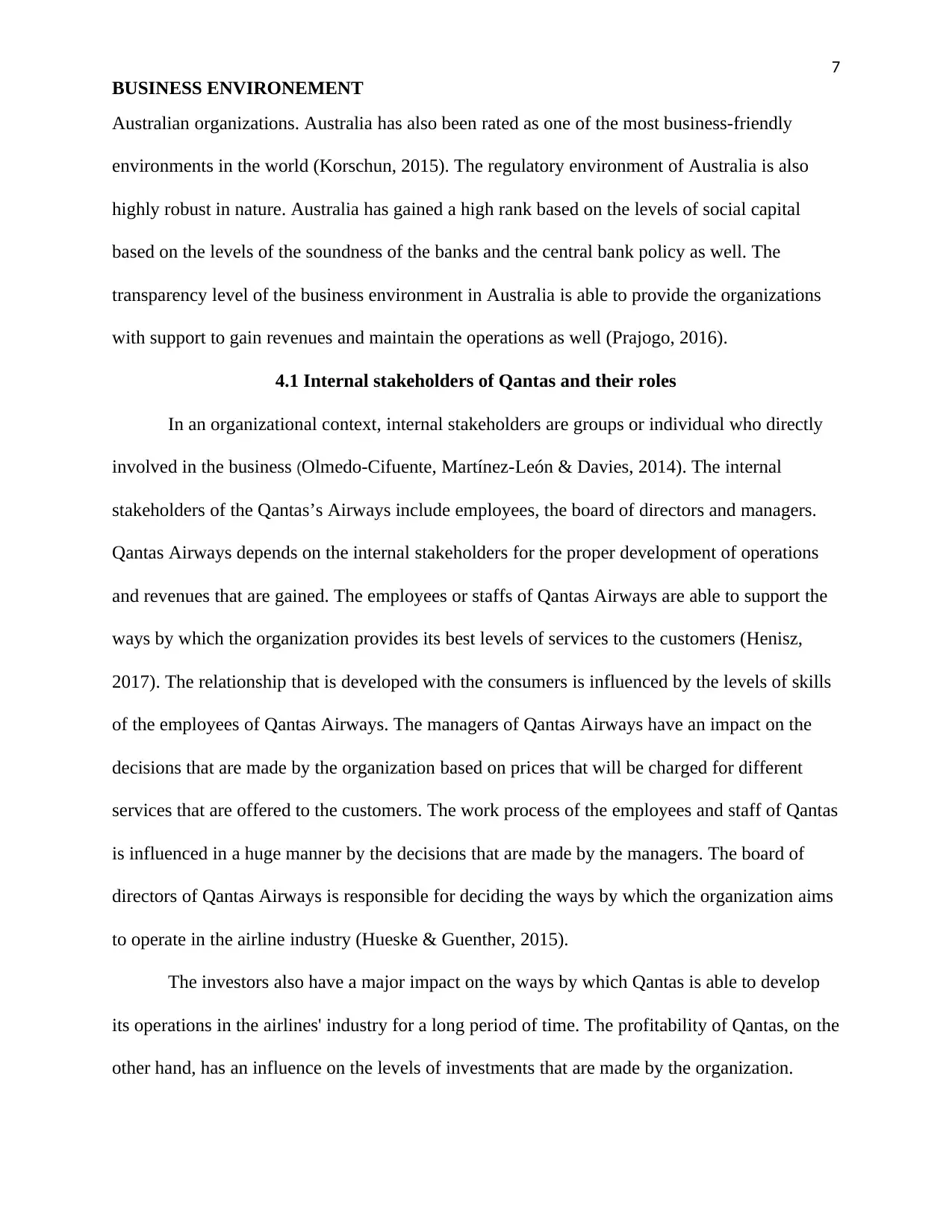
7
BUSINESS ENVIRONEMENT
Australian organizations. Australia has also been rated as one of the most business-friendly
environments in the world (Korschun, 2015). The regulatory environment of Australia is also
highly robust in nature. Australia has gained a high rank based on the levels of social capital
based on the levels of the soundness of the banks and the central bank policy as well. The
transparency level of the business environment in Australia is able to provide the organizations
with support to gain revenues and maintain the operations as well (Prajogo, 2016).
4.1 Internal stakeholders of Qantas and their roles
In an organizational context, internal stakeholders are groups or individual who directly
involved in the business (Olmedo-Cifuente, Martínez-León & Davies, 2014). The internal
stakeholders of the Qantas’s Airways include employees, the board of directors and managers.
Qantas Airways depends on the internal stakeholders for the proper development of operations
and revenues that are gained. The employees or staffs of Qantas Airways are able to support the
ways by which the organization provides its best levels of services to the customers (Henisz,
2017). The relationship that is developed with the consumers is influenced by the levels of skills
of the employees of Qantas Airways. The managers of Qantas Airways have an impact on the
decisions that are made by the organization based on prices that will be charged for different
services that are offered to the customers. The work process of the employees and staff of Qantas
is influenced in a huge manner by the decisions that are made by the managers. The board of
directors of Qantas Airways is responsible for deciding the ways by which the organization aims
to operate in the airline industry (Hueske & Guenther, 2015).
The investors also have a major impact on the ways by which Qantas is able to develop
its operations in the airlines' industry for a long period of time. The profitability of Qantas, on the
other hand, has an influence on the levels of investments that are made by the organization.
BUSINESS ENVIRONEMENT
Australian organizations. Australia has also been rated as one of the most business-friendly
environments in the world (Korschun, 2015). The regulatory environment of Australia is also
highly robust in nature. Australia has gained a high rank based on the levels of social capital
based on the levels of the soundness of the banks and the central bank policy as well. The
transparency level of the business environment in Australia is able to provide the organizations
with support to gain revenues and maintain the operations as well (Prajogo, 2016).
4.1 Internal stakeholders of Qantas and their roles
In an organizational context, internal stakeholders are groups or individual who directly
involved in the business (Olmedo-Cifuente, Martínez-León & Davies, 2014). The internal
stakeholders of the Qantas’s Airways include employees, the board of directors and managers.
Qantas Airways depends on the internal stakeholders for the proper development of operations
and revenues that are gained. The employees or staffs of Qantas Airways are able to support the
ways by which the organization provides its best levels of services to the customers (Henisz,
2017). The relationship that is developed with the consumers is influenced by the levels of skills
of the employees of Qantas Airways. The managers of Qantas Airways have an impact on the
decisions that are made by the organization based on prices that will be charged for different
services that are offered to the customers. The work process of the employees and staff of Qantas
is influenced in a huge manner by the decisions that are made by the managers. The board of
directors of Qantas Airways is responsible for deciding the ways by which the organization aims
to operate in the airline industry (Hueske & Guenther, 2015).
The investors also have a major impact on the ways by which Qantas is able to develop
its operations in the airlines' industry for a long period of time. The profitability of Qantas, on the
other hand, has an influence on the levels of investments that are made by the organization.
Paraphrase This Document
Need a fresh take? Get an instant paraphrase of this document with our AI Paraphraser
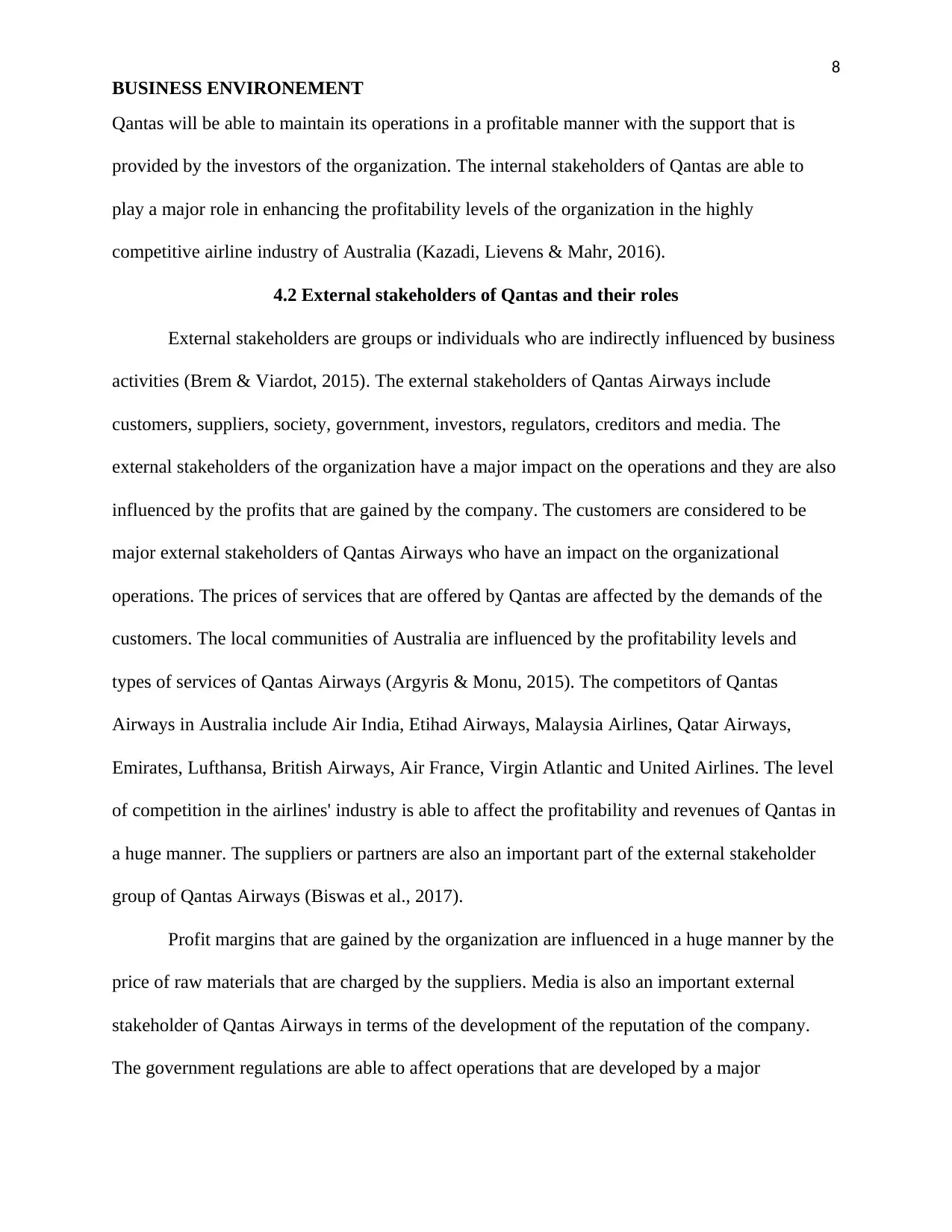
8
BUSINESS ENVIRONEMENT
Qantas will be able to maintain its operations in a profitable manner with the support that is
provided by the investors of the organization. The internal stakeholders of Qantas are able to
play a major role in enhancing the profitability levels of the organization in the highly
competitive airline industry of Australia (Kazadi, Lievens & Mahr, 2016).
4.2 External stakeholders of Qantas and their roles
External stakeholders are groups or individuals who are indirectly influenced by business
activities (Brem & Viardot, 2015). The external stakeholders of Qantas Airways include
customers, suppliers, society, government, investors, regulators, creditors and media. The
external stakeholders of the organization have a major impact on the operations and they are also
influenced by the profits that are gained by the company. The customers are considered to be
major external stakeholders of Qantas Airways who have an impact on the organizational
operations. The prices of services that are offered by Qantas are affected by the demands of the
customers. The local communities of Australia are influenced by the profitability levels and
types of services of Qantas Airways (Argyris & Monu, 2015). The competitors of Qantas
Airways in Australia include Air India, Etihad Airways, Malaysia Airlines, Qatar Airways,
Emirates, Lufthansa, British Airways, Air France, Virgin Atlantic and United Airlines. The level
of competition in the airlines' industry is able to affect the profitability and revenues of Qantas in
a huge manner. The suppliers or partners are also an important part of the external stakeholder
group of Qantas Airways (Biswas et al., 2017).
Profit margins that are gained by the organization are influenced in a huge manner by the
price of raw materials that are charged by the suppliers. Media is also an important external
stakeholder of Qantas Airways in terms of the development of the reputation of the company.
The government regulations are able to affect operations that are developed by a major
BUSINESS ENVIRONEMENT
Qantas will be able to maintain its operations in a profitable manner with the support that is
provided by the investors of the organization. The internal stakeholders of Qantas are able to
play a major role in enhancing the profitability levels of the organization in the highly
competitive airline industry of Australia (Kazadi, Lievens & Mahr, 2016).
4.2 External stakeholders of Qantas and their roles
External stakeholders are groups or individuals who are indirectly influenced by business
activities (Brem & Viardot, 2015). The external stakeholders of Qantas Airways include
customers, suppliers, society, government, investors, regulators, creditors and media. The
external stakeholders of the organization have a major impact on the operations and they are also
influenced by the profits that are gained by the company. The customers are considered to be
major external stakeholders of Qantas Airways who have an impact on the organizational
operations. The prices of services that are offered by Qantas are affected by the demands of the
customers. The local communities of Australia are influenced by the profitability levels and
types of services of Qantas Airways (Argyris & Monu, 2015). The competitors of Qantas
Airways in Australia include Air India, Etihad Airways, Malaysia Airlines, Qatar Airways,
Emirates, Lufthansa, British Airways, Air France, Virgin Atlantic and United Airlines. The level
of competition in the airlines' industry is able to affect the profitability and revenues of Qantas in
a huge manner. The suppliers or partners are also an important part of the external stakeholder
group of Qantas Airways (Biswas et al., 2017).
Profit margins that are gained by the organization are influenced in a huge manner by the
price of raw materials that are charged by the suppliers. Media is also an important external
stakeholder of Qantas Airways in terms of the development of the reputation of the company.
The government regulations are able to affect operations that are developed by a major
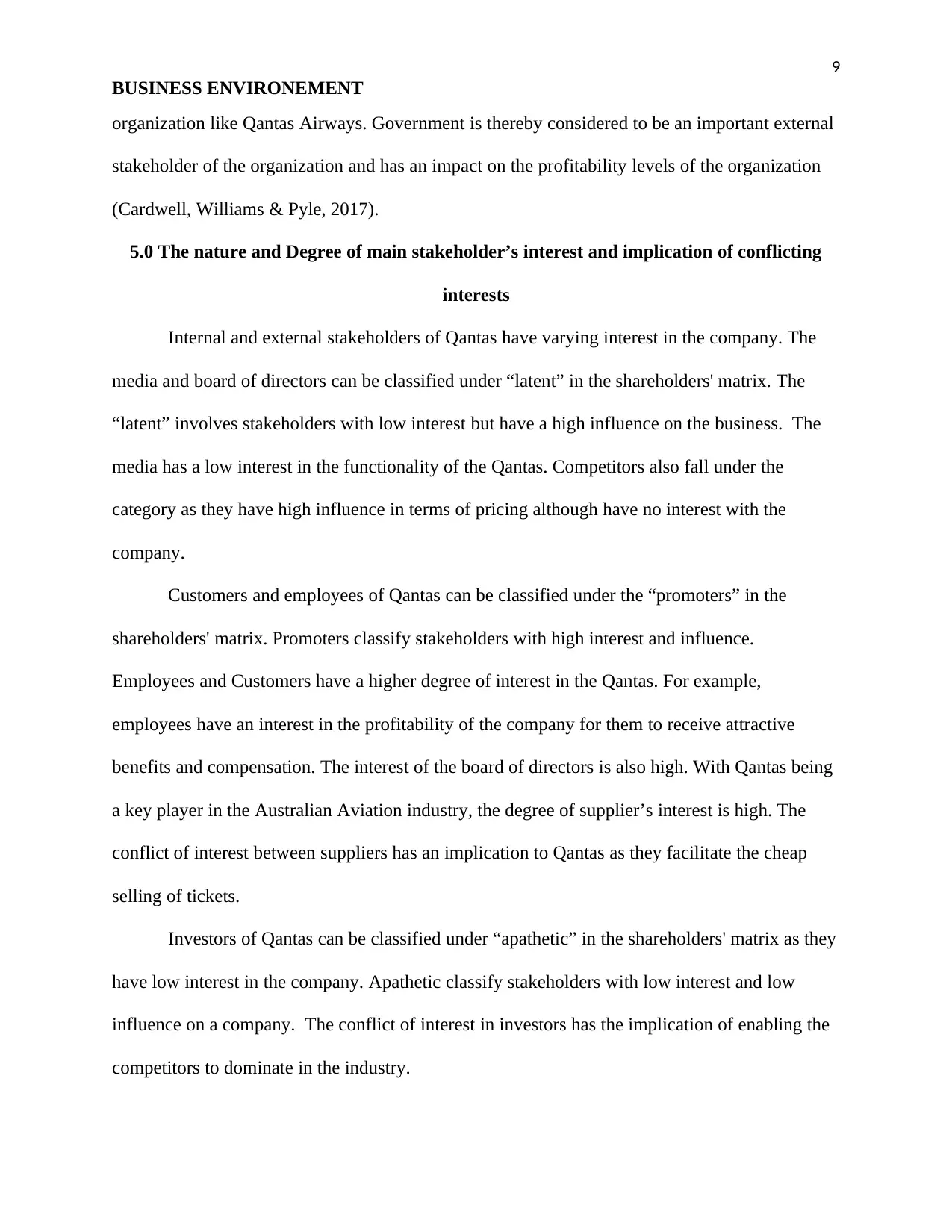
9
BUSINESS ENVIRONEMENT
organization like Qantas Airways. Government is thereby considered to be an important external
stakeholder of the organization and has an impact on the profitability levels of the organization
(Cardwell, Williams & Pyle, 2017).
5.0 The nature and Degree of main stakeholder’s interest and implication of conflicting
interests
Internal and external stakeholders of Qantas have varying interest in the company. The
media and board of directors can be classified under “latent” in the shareholders' matrix. The
“latent” involves stakeholders with low interest but have a high influence on the business. The
media has a low interest in the functionality of the Qantas. Competitors also fall under the
category as they have high influence in terms of pricing although have no interest with the
company.
Customers and employees of Qantas can be classified under the “promoters” in the
shareholders' matrix. Promoters classify stakeholders with high interest and influence.
Employees and Customers have a higher degree of interest in the Qantas. For example,
employees have an interest in the profitability of the company for them to receive attractive
benefits and compensation. The interest of the board of directors is also high. With Qantas being
a key player in the Australian Aviation industry, the degree of supplier’s interest is high. The
conflict of interest between suppliers has an implication to Qantas as they facilitate the cheap
selling of tickets.
Investors of Qantas can be classified under “apathetic” in the shareholders' matrix as they
have low interest in the company. Apathetic classify stakeholders with low interest and low
influence on a company. The conflict of interest in investors has the implication of enabling the
competitors to dominate in the industry.
BUSINESS ENVIRONEMENT
organization like Qantas Airways. Government is thereby considered to be an important external
stakeholder of the organization and has an impact on the profitability levels of the organization
(Cardwell, Williams & Pyle, 2017).
5.0 The nature and Degree of main stakeholder’s interest and implication of conflicting
interests
Internal and external stakeholders of Qantas have varying interest in the company. The
media and board of directors can be classified under “latent” in the shareholders' matrix. The
“latent” involves stakeholders with low interest but have a high influence on the business. The
media has a low interest in the functionality of the Qantas. Competitors also fall under the
category as they have high influence in terms of pricing although have no interest with the
company.
Customers and employees of Qantas can be classified under the “promoters” in the
shareholders' matrix. Promoters classify stakeholders with high interest and influence.
Employees and Customers have a higher degree of interest in the Qantas. For example,
employees have an interest in the profitability of the company for them to receive attractive
benefits and compensation. The interest of the board of directors is also high. With Qantas being
a key player in the Australian Aviation industry, the degree of supplier’s interest is high. The
conflict of interest between suppliers has an implication to Qantas as they facilitate the cheap
selling of tickets.
Investors of Qantas can be classified under “apathetic” in the shareholders' matrix as they
have low interest in the company. Apathetic classify stakeholders with low interest and low
influence on a company. The conflict of interest in investors has the implication of enabling the
competitors to dominate in the industry.
⊘ This is a preview!⊘
Do you want full access?
Subscribe today to unlock all pages.

Trusted by 1+ million students worldwide
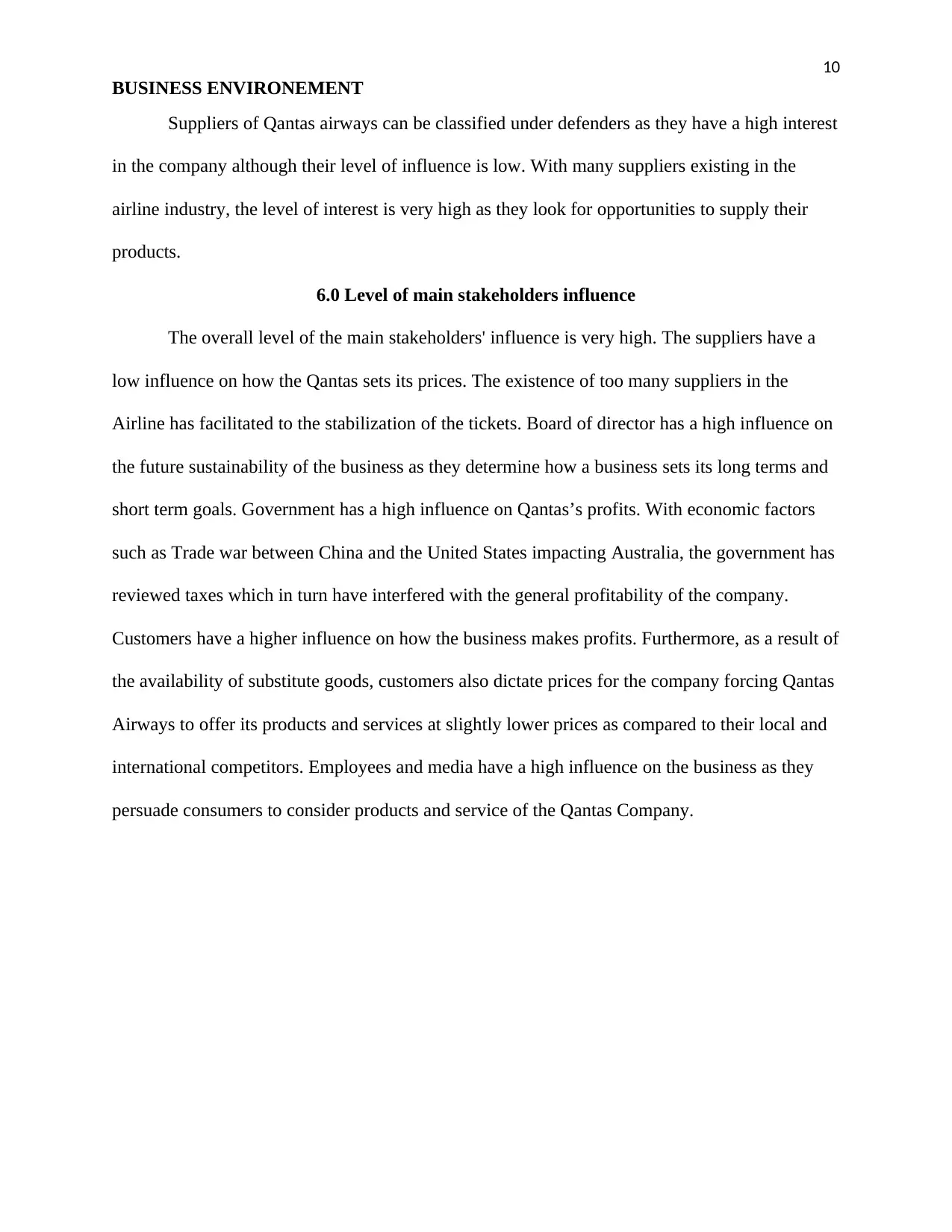
10
BUSINESS ENVIRONEMENT
Suppliers of Qantas airways can be classified under defenders as they have a high interest
in the company although their level of influence is low. With many suppliers existing in the
airline industry, the level of interest is very high as they look for opportunities to supply their
products.
6.0 Level of main stakeholders influence
The overall level of the main stakeholders' influence is very high. The suppliers have a
low influence on how the Qantas sets its prices. The existence of too many suppliers in the
Airline has facilitated to the stabilization of the tickets. Board of director has a high influence on
the future sustainability of the business as they determine how a business sets its long terms and
short term goals. Government has a high influence on Qantas’s profits. With economic factors
such as Trade war between China and the United States impacting Australia, the government has
reviewed taxes which in turn have interfered with the general profitability of the company.
Customers have a higher influence on how the business makes profits. Furthermore, as a result of
the availability of substitute goods, customers also dictate prices for the company forcing Qantas
Airways to offer its products and services at slightly lower prices as compared to their local and
international competitors. Employees and media have a high influence on the business as they
persuade consumers to consider products and service of the Qantas Company.
BUSINESS ENVIRONEMENT
Suppliers of Qantas airways can be classified under defenders as they have a high interest
in the company although their level of influence is low. With many suppliers existing in the
airline industry, the level of interest is very high as they look for opportunities to supply their
products.
6.0 Level of main stakeholders influence
The overall level of the main stakeholders' influence is very high. The suppliers have a
low influence on how the Qantas sets its prices. The existence of too many suppliers in the
Airline has facilitated to the stabilization of the tickets. Board of director has a high influence on
the future sustainability of the business as they determine how a business sets its long terms and
short term goals. Government has a high influence on Qantas’s profits. With economic factors
such as Trade war between China and the United States impacting Australia, the government has
reviewed taxes which in turn have interfered with the general profitability of the company.
Customers have a higher influence on how the business makes profits. Furthermore, as a result of
the availability of substitute goods, customers also dictate prices for the company forcing Qantas
Airways to offer its products and services at slightly lower prices as compared to their local and
international competitors. Employees and media have a high influence on the business as they
persuade consumers to consider products and service of the Qantas Company.
Paraphrase This Document
Need a fresh take? Get an instant paraphrase of this document with our AI Paraphraser
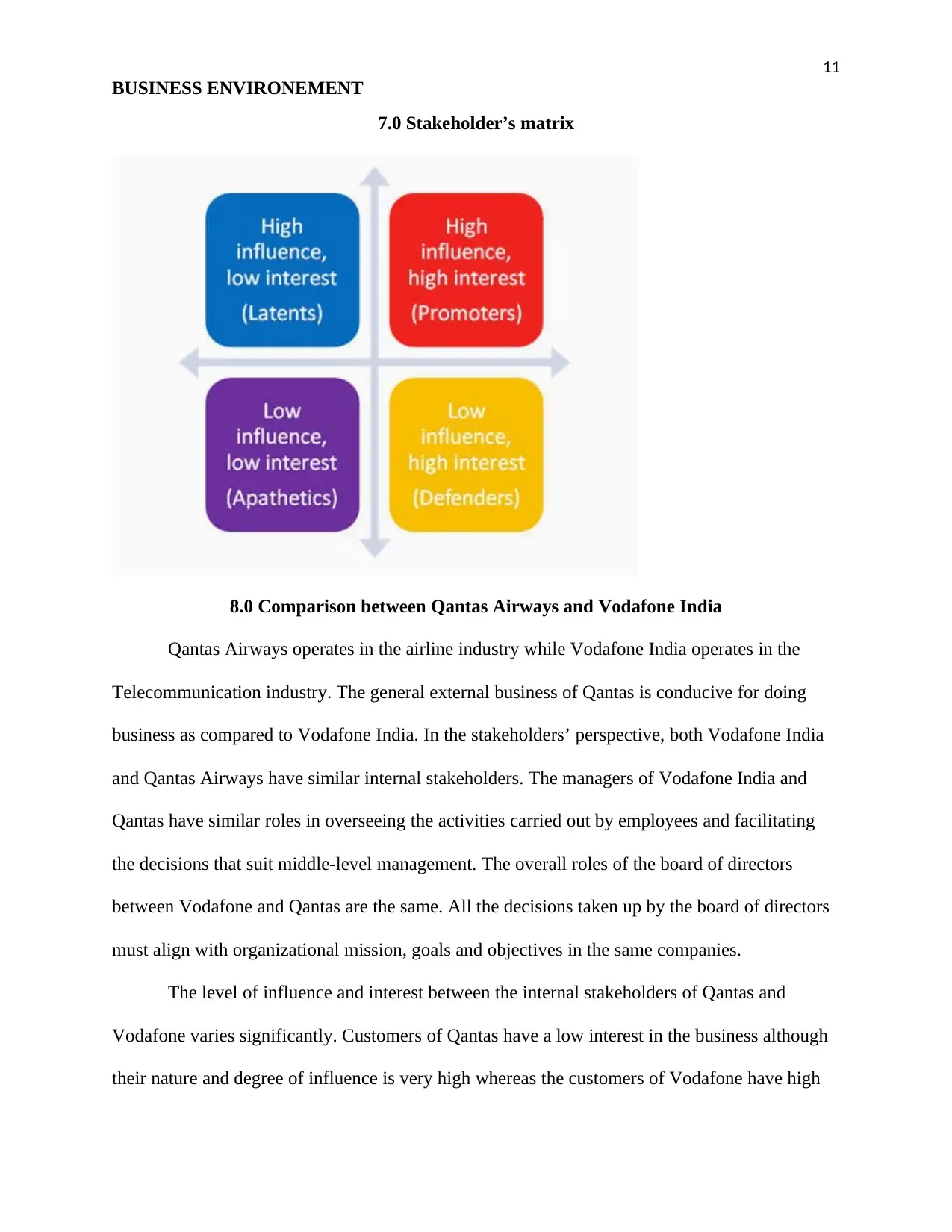
11
BUSINESS ENVIRONEMENT
7.0 Stakeholder’s matrix
8.0 Comparison between Qantas Airways and Vodafone India
Qantas Airways operates in the airline industry while Vodafone India operates in the
Telecommunication industry. The general external business of Qantas is conducive for doing
business as compared to Vodafone India. In the stakeholders’ perspective, both Vodafone India
and Qantas Airways have similar internal stakeholders. The managers of Vodafone India and
Qantas have similar roles in overseeing the activities carried out by employees and facilitating
the decisions that suit middle-level management. The overall roles of the board of directors
between Vodafone and Qantas are the same. All the decisions taken up by the board of directors
must align with organizational mission, goals and objectives in the same companies.
The level of influence and interest between the internal stakeholders of Qantas and
Vodafone varies significantly. Customers of Qantas have a low interest in the business although
their nature and degree of influence is very high whereas the customers of Vodafone have high
BUSINESS ENVIRONEMENT
7.0 Stakeholder’s matrix
8.0 Comparison between Qantas Airways and Vodafone India
Qantas Airways operates in the airline industry while Vodafone India operates in the
Telecommunication industry. The general external business of Qantas is conducive for doing
business as compared to Vodafone India. In the stakeholders’ perspective, both Vodafone India
and Qantas Airways have similar internal stakeholders. The managers of Vodafone India and
Qantas have similar roles in overseeing the activities carried out by employees and facilitating
the decisions that suit middle-level management. The overall roles of the board of directors
between Vodafone and Qantas are the same. All the decisions taken up by the board of directors
must align with organizational mission, goals and objectives in the same companies.
The level of influence and interest between the internal stakeholders of Qantas and
Vodafone varies significantly. Customers of Qantas have a low interest in the business although
their nature and degree of influence is very high whereas the customers of Vodafone have high

12
BUSINESS ENVIRONEMENT
interest and influence at the same time in the business. As a result of high influence in the
businesses, customers of Vodafone influences prices elasticity in the industry significantly when
compared to the Qantas.
The companies also have similar external stakeholders. Similarly, suppliers are mandated
to supply raw materials, customers purchase services and products from the company, the
government regulate the external environment of the industry. Media has low interest and high
influence in the Vodafone industry while in Qantas Company media have low interest and high
influence.
Similarly, the investors of Qantas have low interest and low influence on the business as
compared to those of Vodafone India that have low interest and low influence of the business.
With consideration of economic factors such as high inflation rates in India, high taxation and
slow economic growth (Tripathi & Dash, 2019), investors have resulted to low interest in
Vodafone compared when compared to Australia’s Qantas where the economy is rapidly
growing and there is high GDP (Nguyen & Wang, 2019). Qantas operates in a very competitive
environment consisting of over 5 key players such as Air India, Malaysia, Etihad, Air France and
Emirates as compared to Vodafone Company that has one competitor. With a high level of
competition, the competitors of Qantas have high influence and interest in how Qantas does a
business whereas Vodafone India competitors have low interest and influence of business.
9.0 Conclusion
Internal and external stakeholders of Qantas’s Airways have an impact on how the
business makes profits and sets its prices in the market. Customers and employees are the main
stakeholders of the company that have a very higher influence on the business. The decisions and
strategies made by the internal stakeholders such as managers and board of directors determine
BUSINESS ENVIRONEMENT
interest and influence at the same time in the business. As a result of high influence in the
businesses, customers of Vodafone influences prices elasticity in the industry significantly when
compared to the Qantas.
The companies also have similar external stakeholders. Similarly, suppliers are mandated
to supply raw materials, customers purchase services and products from the company, the
government regulate the external environment of the industry. Media has low interest and high
influence in the Vodafone industry while in Qantas Company media have low interest and high
influence.
Similarly, the investors of Qantas have low interest and low influence on the business as
compared to those of Vodafone India that have low interest and low influence of the business.
With consideration of economic factors such as high inflation rates in India, high taxation and
slow economic growth (Tripathi & Dash, 2019), investors have resulted to low interest in
Vodafone compared when compared to Australia’s Qantas where the economy is rapidly
growing and there is high GDP (Nguyen & Wang, 2019). Qantas operates in a very competitive
environment consisting of over 5 key players such as Air India, Malaysia, Etihad, Air France and
Emirates as compared to Vodafone Company that has one competitor. With a high level of
competition, the competitors of Qantas have high influence and interest in how Qantas does a
business whereas Vodafone India competitors have low interest and influence of business.
9.0 Conclusion
Internal and external stakeholders of Qantas’s Airways have an impact on how the
business makes profits and sets its prices in the market. Customers and employees are the main
stakeholders of the company that have a very higher influence on the business. The decisions and
strategies made by the internal stakeholders such as managers and board of directors determine
⊘ This is a preview!⊘
Do you want full access?
Subscribe today to unlock all pages.

Trusted by 1+ million students worldwide
1 out of 16
Related Documents
Your All-in-One AI-Powered Toolkit for Academic Success.
+13062052269
info@desklib.com
Available 24*7 on WhatsApp / Email
![[object Object]](/_next/static/media/star-bottom.7253800d.svg)
Unlock your academic potential
Copyright © 2020–2025 A2Z Services. All Rights Reserved. Developed and managed by ZUCOL.





